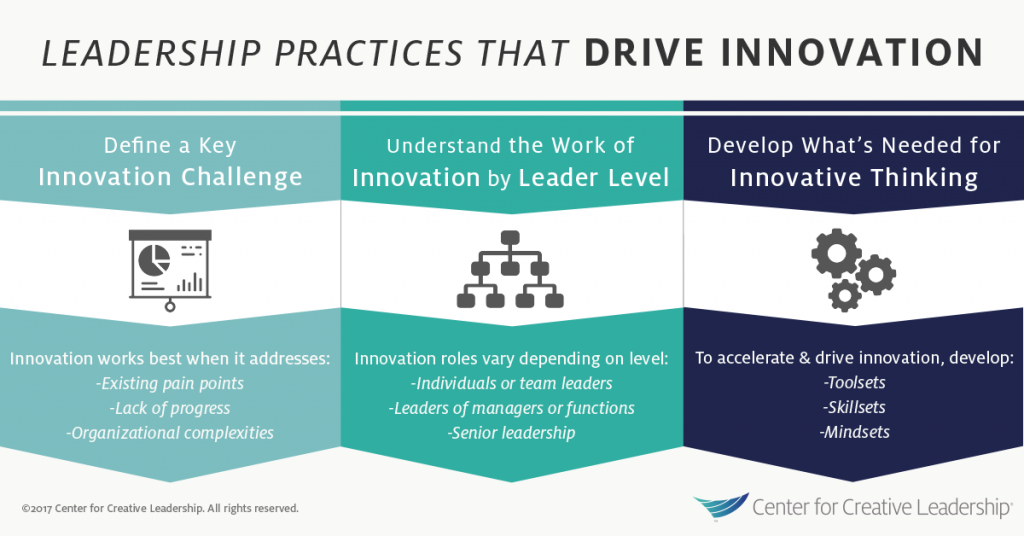3 Practices That Will Help Drive Innovation in Your Organization
How do you make “innovation” more than a buzzword?
If you’re like most executives, managers, and HR professionals, you’ve been talking about how to instill a culture of innovative thinking in your organization — but unsure of how to approach the challenge.
A recent CCL survey of 500 senior leaders found that innovation is a key driver of success for 94% of organizations, and 77% of them tried to promote innovation is some way. Even so, just 14% said they were confident about their organization’s ability to drive innovation effectively.
We expect this gap exists because too many companies invest in structures, programs, and efforts to fuel innovative thinking without also investing in innovation leadership.
We suggest focusing on the leadership capabilities that drive innovation. Here are 3 practices:
- Is important to you, your team, or the organization — and over which you have some ownership or influence.
- Involves others who also have a significant investment in the outcomes.
- Has persisted over a period of time and requires some creativity and imagination to resolve.
- May require changes in assumptions, behaviors, or standard operating procedure for those involved.
Examples include:
- How might I get multiple stakeholders (internal and external) to share resources and partner better?
- In what ways might we improve the profitability of this product line/service?
- How to improve our ability to rival new competitors in a specific channel?
- What might be all the ways to get into a given market?

Understand the Work of Innovation by Leader Level
Understanding the work of innovation by level can help leaders focus (how do I drive innovation in my organization?) and helps you target training and development.
- Individual leaders are responsible for ideation and creation. Their innovation work involves seeking and generating novel solutions and approaches, participating on innovation teams, and pushing across boundaries.
- Team leaders may be managers, line supervisors, or project leaders who are accountable for team performance and managing resources. Their innovation work includes leading group innovation processes and obtaining resources from outside their unit.
- Leaders of managers support innovation teams by serving as connectors and champions. Their role includes supporting and protecting the innovation team from organizational systems, building a case for grassroots innovations, and facilitating cooperation between groups working on similar opportunities.
- Leaders of functions help develop the innovation strategy and manage the pipeline of new products, processes, and services. They need to bridge silos and initiate changes to accommodate promising innovations.
- Senior leadership sets innovation strategy for the organization. These executives shape the culture so that “new, different, and disruptive” ideas are supported throughout the organization. This includes finding ways to view concepts not filtered by many layers of management, modeling behavior, and communicating the vision of innovation.
Develop What’s Needed for Innovative Thinking
Effective innovative thinking requires all 3:
- Toolsets: Most people interested in promoting innovation look first to tools and techniques. An effective toolset can be a critical part of driving innovation in an organization — and there are countless resources out there. Prototyping, brainstorming, mind mapping, and excursions are just a few.
- Skillsets: Innovation leadership also requires facility, practice, and mastery of processes — a framework that allows innovation leaders to use their toolset, knowledge, and abilities to accomplish their goals.
- Mindset: A leader’s mindset is the attitudes and resulting behaviors that allow the tools and skills to be effective. It distinguishes those leaders who demonstrate and enable creative thinking and innovation from those who shut it down. An innovation mindset includes curiosity, the ability to defer judgment, tolerance for ambiguity, courage, attentiveness, and grasp of polarities.
Leadership makes innovation happen. Without leadership, ideas aren’t pursued, acted upon or transformed into game-changing products, processes, services, or solutions.


Comments